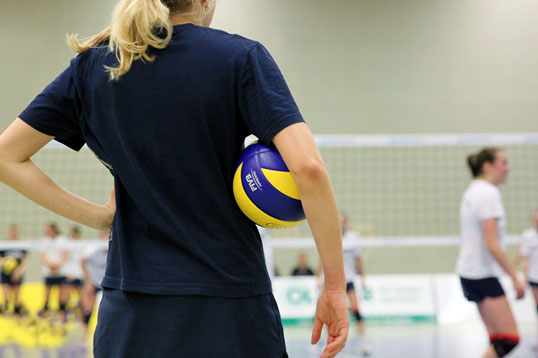Volleyball: Creating competitive game-like drills
The best drill to teach passing is one where you pass-set-hit; the best drill to teach setting is one where you pass-set-hit; and the best drill teach hitting is to pass-set-hit.
Those words, attributed to former national team coach Marv Dunphy, imply that skills are best learned within the context of the game and not as isolated entities. John Kessel, director of player development for USA Volleyball, refers to what he calls “grills” to emphasize that drills need to be game-like in nature.
Developing game-like, competitive drills involves putting emphasis on a specific aspect of the sport by playing a game. This can be done by manipulating one or more of the following variables:
- Dimensions of the court.
- Scoring system.
- Number of players used.
- Setting specific rules of play.
- Changing the way the drill is initiated.
In many cases, two or more of these variables are combined. For example, a “2-on-2 short-court” drill, which changes the dimensions of the court and the number of players.
» RELATED: Tips for using your middle blocker
These types of drills:
- Develop skills within the context of the game.
- Force players to think and stay mentally engaged.
- Help players learn to execute a game plan.
- Teach players to compete and find ways to win.
- Are fun for the athletes because they get to play.
- Allow for the development of game-like drills that do not involve 6-on-6 play. This is important for club teams that typically have fewer than 12 players.
A possible disadvantage is that an individual player may not get enough reps with game play only. An ideal practice format would include individual work in the early part of practice to work on the skills, which will be used in the group/team drills to be played later in the practice. For example, before playing the line hitting/digging drill described here, the coach could drill the individual action of line digging by repeatedly hitting from a box to a line digger or repetitive line hitting from a hitting line.
Another important aspect to consider is the skill level of the players. For example, the players may not have the individual setting, hitting or digging skills necessary to make the game competitive or time productive. Therefore, these drills must be carefully planned and adjusted to skill level.
The following are examples illustrating each of the variables:
Changing court dimensions
Use cones, poly spots or long elastic bands to make a new “court” and just play. Adjust the court size to fit the level of play; smaller areas benefit the defense while a larger area benefits the offense. Simply mark off the line alley on both sides of the net and just play a regular game; a ball hit outside of the “line alley” is out of bounds. Play may be initiated by either chipping in a ball or start with a serve and pass within the “normal” court. Play can be 4-on-4, 5-on-5 or 6-on-6; add a middle attacker who must run slides and hit down the line; add a middle back to pick up the deep roll/tip or if your team plays a rotation defense.

To work on cross-court/cut shots by the left side hitter, play 4-on-4 as shown in DIAGRAM 1 (three front row positions plus one back), 3-on-3 without a middle blocker, or 5 on 5 and play the setter in right back. You may need to dictate to the blocker where to set the block, for example, make sure you leave the line open or allow the inside cut shot, otherwise blockers begin to cheat since they know where the attack is going. However, that’s not always bad because it helps develop the idea of executing a game plan. For example, you must take away the line shot, and it teaches the digger to then read that the line is blocked and release up for a tip.
Another very popular example is to play 2-on-2 “short court” or play half court lengthwise.
Scoring system
Play a “normal” game but use the scoring system to place emphasis on different aspects of the game.
For example, only the middle may score a point to emphasis middle attacking, and if anyone else scores that team receives the next ball but does not score a point. This concept may be applied to any court position.
Coaches can add bonus points for a particular skill, like counting a backrow kill as two points. You also can start games at a designated score — 22-22 or 22-20 — to simulate late game situations. It’s also a good idea to play with designated scores but not let the teams know what score they need to win. This forces players to focus on winning the next play instead of thinking about the bigger picture.
Adjusting number of players
Modify drills with the number of players on the court. Play 3-on-3 — all in the backrow or 4-on-4 with a middle — to work on attacking and digging backrow attacks.
You also can play 5-on-5 with no middle to work on attacking and blocking/digging in 1-on-1 situations, or 5-on-5 with no left front and the setter in the front row. That emphasizes forcing the middle attack.
Setting specific rules
Set rules so the ball may only be passed/dug with the hands to work on overhead passing and digging. Or stipulate that attacks must be a tip or roll shot to work on hitting and defending off speed.
Coaches can make it so only a designated player may attack — middle front or backrow players — and everyone else must return the ball with a free ball. Or dictate that one side may only use two contacts or they must only return with a free ball to allow the other side to get a lot of transition work from down/free ball situations.
Change initiation of play
This allows the coach to put the team into a specific situation from which to start play. It’s a great way to work on out-of-system situations.
Try starting play by tossing a ball above the net for the two sides to “joust” and play out from there. Or bounce a ball for one side and have them send a free ball to the other side to work on free-ball transition. You could even bounce a ball on one side which is the first contact, and the team has two more contacts to get the ball over the net.
Another option is to chip a ball to a backcourt player, who digs to self and then sets a hitter so the hitters are hitting sets coming from different areas of the court.
By keeping these variables in mind, and with a little creativity, any coach can develop game-like drills appropriate for his or her team.
Mark Britner is in his 39th year of coaching, including 19 years at the collegiate level and 25 years of club volleyball. This article is a recent post from the Junior Volleyball Association blog, providing education for club directors, coaches, players and fans. Learn more at www.jvaonline.org.




